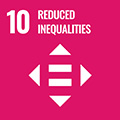- Docente: Cristina Brasili
- Credits: 8
- SSD: SECS-P/02
- Language: Italian
- Teaching Mode: In-person learning (entirely or partially)
- Campus: Bologna
- Corso: Second cycle degree programme (LM) in Local and Global Development (cod. 5912)
-
from Mar 03, 2025 to May 29, 2025
Learning outcomes
The course intends to provide an in-depth knowledge of the main economic policies of regional and, more generally, territorial, Italian and European development. At the end of the course, the student is able to: a) use methodological and analytical tools that allow him to evaluate and support regional economic policy decisions; b) choose and analyse indicators useful for the interpretation of local social and economic contexts.
Course contents
-The EU Cohesion Policy (8 frontal hours and 4 laboratory hours):
- Objectives and principles of the EU Cohesion Policy
- The Structural Funds and the National Strategic Framework in the 2007-2013 programming, the characteristics of the programming period of the 2014-2020 Cohesion Policy.
-The implementation of the Cohesion Policy in some European regions.
-In-depth analysis of the critical issues in the implementation of the Cohesion Policy in some Italian regions
-The database for development policies (DPS, Istat).
- Program documents: the 2014-2020 Partnership agreement
Local development theory (4 lectures and 2 laboratory hours)
- The Italian Industrial Districts: evolution, characteristics and governance;
-The National Strategy of internal areas (SNAI)
Indicators for measuring territorial capital and well-being (4 frontal hours and 4 laboratory hours)
- The territorial capital in the Italian regions and cities
- The BES project: indicators of Fair and Sustainable Wellbeing
- The quality of life in cities - Eurostat's Urban database
Economic growth theory and growth factors (8 lectures and 2 laboratory hours):
-Economic growth
- Productivity in Italy
- Institutional Quality
The EU budget 2021-2027. The setting of the Cohesion Policy 2021-2027 and the PNRR in Italy (4 hours)
Readings/Bibliography
- Growth Factors
La crescita delle nazioni, fatti e teorie di Vittorio Daniele, Rubbettino Editore, 2008, Capitoli Primo e Secondo, pp.9-64
- Local Development and Territorial Capital
Lo sviluppo locale– Ciapetti, 2010
Gianfranco Viesti (2021) Centri e periferie, Europa, Italia e Mezzogiorno dal XX al XXI secolo, capitoli 7, 15 e 16 4-5, Editori Laterza;
RegiosS - Gli indicatori per la misura del capitale territoriale, 2012
- UE Cohesion Policy
Politica Regionale – Commissione Europea [http://www2.stat.unibo.it/brasili/polec_2017/regional_policy_it.pdf]
I fondi strutturali europei: otto lezioni dall'esperienza italiana – Viesti, Luongo 2014
Le nuove politiche regionali dell'Unione Europea – Viesti, Prota – Cap.7
Le nuove politiche regionali dell'Unione Europea – Viesti, Prota – Cap.8
Investire nelle regioni: la riforma della Politica di coesione dell’UE 2014-2020
Sintesi dell’accordo di partenariato per l’Italia, 2014-2020, European Commission 2014
Accordo di partenariato 2014-2020 Italia allegato 1 risultati attesi - azioni
- Institutional Quality
Charron Rothstein - Quality of Government in EU regions
- SNAI Strategy
Barca F., Casavola P., Lucatelli S. (2014) “Strategia nazionale per le Aree interne: definizione, obiettivi, strumenti e governance” in Materiali Uval, n. 31, Roma Italia Carlucci C., Guerrizio A.
Further readings:
-
Italia e Germania: due vie per l’uscita dalla crisi – A. Brasili C. Brasili, 2011;
Città e sviluppo locale – Bertini, Brasili, 2014;
-
"What Is Quality of Government? A Theory of Impartial Government Institutions", Rothstein, Teorell, 2008;
-
Rothstein B., Stolle D., 2008: The state and social capital: An institutional theory of generalized trust, Comparative Politics, 40 (4): 441-459; -Social Capital and Governmental Institutions, 2012, Breuskin;
- Un bilancio moderno al servizio di un'Unione che protegge, che dà forza, che difende;-Quadro finanziario pluriennale 2021-2027; -Politica di coesione e la crisi generata dalla pandemia da COVID-19; -Una nuova agenda strategica 2019-2024;-Consiglio Europeo, Comunicazione della Commissione: “Il momento dell'Europa: riparare i danni e preparare il futuro per la prossima generazione”;-Comunicazione della Commissione: “Il bilancio dell'UE come motore del piano per la ripresa europea”.
- La nuova politica di coesione 2021-2027, Rapporto camera dei deputati del 5 Giugno 2019( con aggiornamenti); -Presidenza del Consiglio dei Ministri “La programmazione per la Politica di Coesione, documento preparatorio per il confronto.
-
European Commission, Ninth Cohesion Report, March 2024
Additional material provided by the teacher during the course
Teaching methods
The teaching method followed is to theoretically address a problem of economic policy (through frontal lessons) and then to show the empirical analysis approach through the use and discussion of data related to the problem in the lessons in the laboratory.
Some topics will be explored in depth by the students, and the assignments will be agreed upon with the students themselves during the course.
Assessment methods
Verification of the degree of learning of the topics covered will be conducted in two ways: a) an oral exam that focuses on the entire program of the course and b) at the student's choice the preparation of a paper agreed during the course that will be delivered one week before the appeal and presented during the exam.
The evaluation in the case of mode a) will be given according to the following criterion:
-Analytical ability that emerges only with the help of the teacher, expression in overall correct language → 18-19;
-Ability of autonomous analysis, expression in correct language → 20-24;
-Ability to carry out critical analysis, mastery of specific terminology → 25-29;
-Ability to carry out critical and connecting analysis, full mastery of specific terminology and ability to argue and self-reflect → 30-30 L
The evaluation in the case of modality b) will be given according:
1)The topics not covered in the paper will be briefly discussed during one of the subsequent exam sessions. The maximum number of points obtainable from this test is 16.
OR 2) For attending students, the assignments required during the course will be evaluated (for a total of 16 points)
Topic and index of the paper must be agreed in advance with one of the teachers
The paper must answer a short research question, must have a maximum length of 10-15 pages, must be sent by email to Professor Brasili and / or Professor Moscariello one week before the date of presentation, the maximum score for the paper is 16 points
The exam grade will be given by the sum of the scores obtained from the presentation of the paper and the oral exam (assessed according to the criteria of method a).
Scores 31 and 32 correspond to 30 cum lode
In particular, we intend to verify the achievement of the following educational objectives:
- knowledge of the economic policies of the European Union and its links with Italian and international ones;
- appropriate use of the methodological tools illustrated during the lectures;
- ability to ask Research Questions concerning the use of these tools to analyze the effects of policies;
- ability to discuss the results obtained in order to interpret the phenomenon under study, in the light of the literature on the subject and current economic policy strategies.
REFUSAL OF THE MARK: The student who passes the exam (in both ways) can refuse the mark only once. This principle complies with what is specified in the University Teaching Regulations, art. 16, co. 5, modified by the resolution of the Academic Senate approved by the Board of Directors in February 2018: "in the event of a positive outcome, the student can ask to refuse the grade. The refusal must be granted by the teacher at least once on the single course". After a refusal, any positive outcome will be recorded.
Teaching tools
Reading materials can be found at:
Unibo Virtuale - Università di Bologna https://virtuale.unibo.it
Lessons will not be recorded.
The main sources of regional economic, national and international data will be illustrated.
Office hours
See the website of Cristina Brasili
SDGs




This teaching activity contributes to the achievement of the Sustainable Development Goals of the UN 2030 Agenda.
